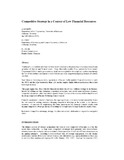| dc.contributor.author | Ngowi, A.B. | |
| dc.contributor.author | Iwisi, D. | |
| dc.contributor.author | Mushi, R. | |
| dc.date.accessioned | 2008-10-31T10:40:45Z | |
| dc.date.available | 2008-10-31T10:40:45Z | |
| dc.date.issued | 2002 | |
| dc.identifier.citation | Ngowi, A.B. et al (2002) Competitive Strategy in a Context of Low Financial Resources, Building Research & Information, Vol. 30, Issue 3, pp. 205-211 | en |
| dc.identifier.issn | 1466 4321 | |
| dc.identifier.uri | http://hdl.handle.net/10311/264 | |
| dc.description.abstract | Traditionally, competitive advantage has been based upon large-scale production and accumulation of large
quantities of physical and financial assets. Large financially capable firms, particularly Multi-national
Corporations (MNCs) and large construction firms create competitive advantages and sustain them through
the use of such defence mechanisms as entry barriers and other competition-impeding features of industry
structure. Small firms in developing countries, especially in Africa can hardly mobilize financial resources to match
the MNCs and the large construction firms, nor can they employ similar defence mechanisms due to their
lack of global reach.Using the construction industry in Botswana, the paper reports on a pilot study that investigated the factors
that are crucial to creating constantly changing competitive advantage in the context of low financial
resources. It concludes by emphasizing that firms operating in low financial contexts should create
dynamic competitive advantages instead of imitating the strategies used by large financially capable firms. | en |
| dc.language.iso | en | en |
| dc.publisher | Taylor and Francis Ltd. http://www.tandf.co.uk/journals/titles/09613218.asp | en |
| dc.subject | Competitive advantage | en |
| dc.subject | strategy | en |
| dc.subject | low financial context | en |
| dc.subject | Multi-national corporation | en |
| dc.subject | global reach | en |
| dc.title | Competitive Strategy in a Context of Low Financial Resources | en |
| dc.type | Article | en |

